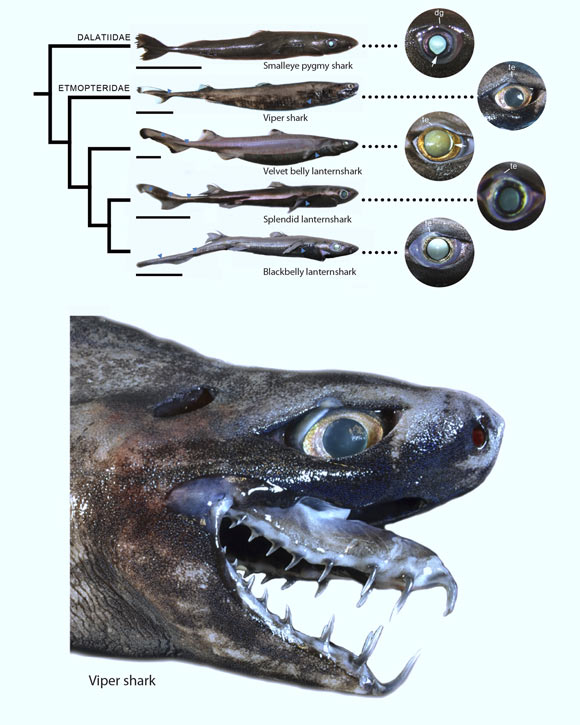According to a new study published in the journal PLoS ONE, the eyes of mesopelagic bioluminescent sharks have a higher rod density when compared to other sharks. This adaptation is one of many these deep-sea creatures use to produce and perceive bioluminescent light in order to communicate, find prey, and camouflage themselves against predators.

Top: phylogeny of sharks analyzed by the team and close-ups of their eyes. Bottom: head of the Viper shark with protruded jaws; note how binocular vision is prevented frontally by an enlarged snout. Image credit: Claes JM et al.
The mesopelagic twilight zone, or about 200-1,000 m deep in the sea, is a vast, dim habitat, where, with increasing depth, sunlight is progressively replaced by point-like bioluminescent emissions.
To better understand strategies used by bioluminescent predators, Dr Julien Claes of the Université Catholique de Louvain and his colleagues investigated the visual ecology of five deep-sea bioluminescent sharks.
They analyzed the eye shape, structure, and retinal cell mapping in the visual systems of four Lanternsharks (Etmopteridae) – the Blackbelly lanternshark, the Splendid lanternshark, the Velvet belly lanternshark, the Viper shark, and one kitefin shark (Dalatiidae) – the Smalleye pygmy shark.
The scientists found that the sharks’ eyes contained a translucent area present in the upper eye orbit of the lantern sharks, which might aid in adjusting counter-illumination, or in using bioluminescence to camouflage the fish.
They also found several ocular specializations, such as a gap between the lens and iris that allows extra light to the retina, which was previously unknown in sharks.
Bioluminescent sharks possess higher rod densities in their eyes, which might provide them with improved temporal resolution.
“Every bioluminescent signal needs to reach a target photoreceptor to be ecologically efficient,” Dr Claes explained.
“We clearly found evidence that the visual system of bioluminescent sharks has co-evolved with their light-producing capability, even though more work is needed to understand the full story.”
_____
Claes JM et al. 2014. Photon Hunting in the Twilight Zone: Visual Features of Mesopelagic Bioluminescent Sharks. PLoS ONE 9 (8): e104213; doi: 10.1371/journal.pone.0104213







